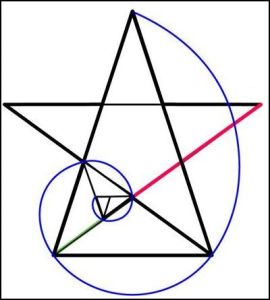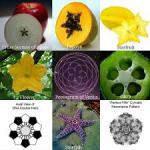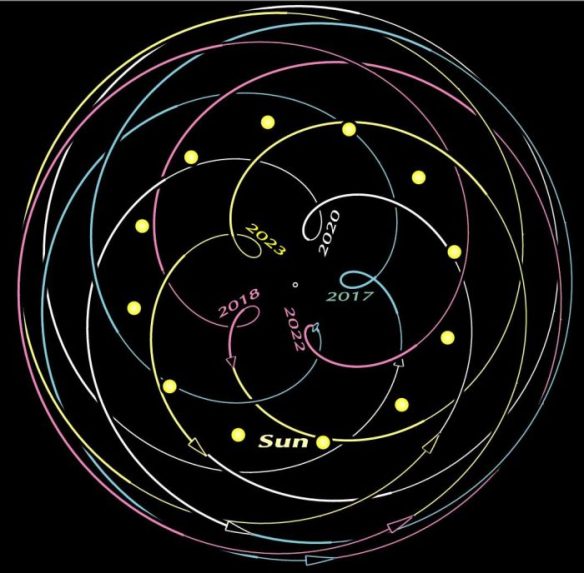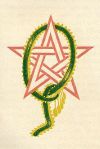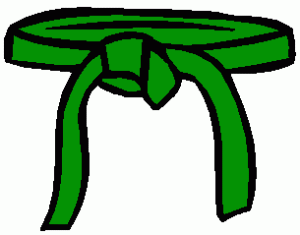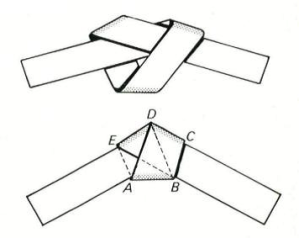About Venus, Virgin Mary and “The Pentacle” of Sir Gawain
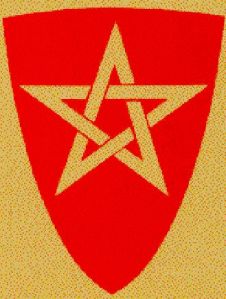 Celtic Symbolism : “The Pentacle” on the Medieval Poem “Sir Gawain and the Green Knight”
Celtic Symbolism : “The Pentacle” on the Medieval Poem “Sir Gawain and the Green Knight”
“Then they showed forth the shield, that shone all red,
With the pentangle portrayed in purest gold.
And why the pentangle is proper to that peerless prince
I intend now to tell, though detain me it must.”
(Sir Gawain and the G. K. 2.619-623).
An anonymous contemporary of Geoffrey Chaucer wrote Sir Gawain and the Green Knight in the 14th century, outlining an adventure of Sir Gawain, a knight of King Arthur’s Round Table.
Gawain represented the perfect knight, as a fighter, a lover, and a religious devotee.
It was written in a Northern dialect and uses alliteration similar to the Anglo-Saxon form of poetry. Alliteration is characterized by the repetition of consonants and a sharp rhyme at the end of each section.
The story begins as King Arthur’s court celebrates the New Year for fifteen days. The lords and ladies of the court are having a great time dancing and feasting. The story describes the lavishly served feast with all the trimmings. Each guest is free to partake in the royal meal. However, King Arthur will not eat on such a high holiday until someone tells a fascinating or adventurous tale.
After a year has passed, Sir Gawain must prepare to leave for his journey to the castle of the Green Knight. The other knights are sad to see such a good friend and stellar knight meet with such a bitter blow. Gawain’s answer to the concerns of his fellow knights demonstrates his bravery: “Why should I tarry? In destinies sad or merry, True men can but try.“
The poem describes Gawain’s armor in detail. He carries a red shield that has a pentangle painted on its front. The pentangle is a token of truth. Each of the five points are linked and locked with the next, forming what is called the endless knot. The pentangle is a symbol that Gawain is faultless in his five senses, never found to fail in his five fingers, faithful to the five wounds that Christ received on the cross, strengthened by the five joys that the Virgin Mary had in Jesus (The Annunciation, Nativity, Resurrection, Ascension, and Assumption), and possesses brotherly love, pure mind and manners, and compassion most precious. The inside of the shield is adorned with an image of the Virgin Mary to make sure that Gawain never loses heart.
Long before the narrator of Sir Gawain and the Green Knight placed the pentangle on the shield of “that peerless prince,” it was an object of importance, and has enjoyed a place in the philosophical and theological forums of many cultures. The earliest found depiction of the pentangle, located on a piece of pottery found in the ruins of the ancient city of Ur, dates back to around 900 BCE, placing it well within the early Babylonian period (Stone, 135). The Pythagoreans where fascinated by its mathematical and geometrical implications and spent much of the 3rd 4th and 5th centuries BCE trying to unlock its mysteries. In fact, most all Greek geometry, mathematics, and architecture are based on the perfect harmony found in the pentangle. The neo-Platonists and the Gnostics could not resist the call of the pentangle, and tied many of their studies and mysteries to this eminent symbol. However, the pentangle gained its most prominent state in the Middle Ages when Christianly and Islam adopted this symbol as a major part of their religions, both using it as a symbol of harmony, virtue, and idealism (Hulbert, 722).
The regular pentangle is formed from a regular pentagon, either by drawing its diagonals or by extending each edge until it meets other edges that are not its immediate neighbors. The edges of the regular pentangle divide each other so that the ratio of the larger part to the smaller part is equal to the ratio of the whole line to the larger part (Cundy & Rollett, 68-77). This ratio, (1 + square root of 5/2), was named by the Pythagoreans as the ‘Golden Ratio’ and is commonly represented by the Greek symbol Phi.
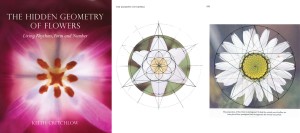 Keith Critchlow: The Hidden Geometry of Flower
Keith Critchlow: The Hidden Geometry of Flower
Professor Critchlow has published many books and papers on cosmology, architecture, and geometry, which he sees as a karma yoga. These include ‘Order in Space’, ‘Time Stands Still’, and ‘Islamic Patterns: An Analytical and Cosmological Approach’. As he says, “All authentic academic research is based on the simultaneous pursuit of the True, the Beautiful, and the Good—if any is pursued separately, imbalance ensues.” He continues his research into five-fold and ten-fold symmetries, an area that has held his interest for many years. see The School of Traditional Art
Five petals of Venus
When plotted geocentrically – from an Earth-centered perspective – there is a highly noticeable rhythm in the motion of Venus. After 8 years, it returns to the same place in the sky on the same date. This was known to, and of great interest to, ancient peoples such as the Maya, and many today know it as the famous Venus cycle, or the pentagram of Venus.
Over eight years, each phenomenon – each relative position of Earth, Venus, and the sun – occurs five times, and then over the next eight years they repeat five times almost identically.
For Venus, the tight inward loops are the inferior conjunctions, in which Venus passes between us and the sun; the wide swings are centered on the superior conjunctions, when Venus passes around the far side of the sun. So the general pattern is (as Anthony Barreiro commented):
… a lovely five-petalled rose.
The tight loops are the stamens of the rose, the wide swings are the petals.
When I tried to plot a geocentric picture over eight years (2016-2023) to show the complete rose, it was bewilderingly cluttered. It had five overlapping tracks, eight-times-twelve little Venus globes at monthly intervals – already too much without the ecliptic-plane grid and other details.
The image at the top of this post is a more simplified version: still calculated in three dimensions, but, by moving the viewpoint to the north ecliptic pole, it becomes a flat plan of Venus’s path.
Earth is in the middle; the vernal-equinox direction is to the right; the yellow spots are the sun at the beginning of each month.
The rest is the rhythmic motions of Venus.
You’ll still have trouble deciphering which part of the track is for which year (I’ve used white, cyan, magenta, yellow for 2016, 2017, 2018, 2019, and again for 2020, 2021, 2022, 2023) but it doesn’t matter greatly. You can see the five inferior conjunctions, in their five directions.
If you trace across the circle from each loop to the next, you see that they are not adjacent to each other but 2/5 pf the way around, like the five points of a pentagram.
Planet venus-geocentric-2016-2023:
-Successive inferior conjunctions of Venus against the Zodiac form a Pentagram.
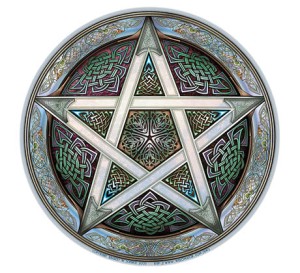 The Pentacle’s “Five-ness” of Moral Virtues
The Pentacle’s “Five-ness” of Moral Virtues
In Sir Gawain and the Green Knight the narrator employs the pentangle to illustrate the central conflict within the story, which is Gawain’s inner fight, rather than his ordeal with the Green Knight.
Each of the five points of the pentangle represents a set of Gawain’s virtues: his five senses, for he is “faultless in his five senses;” his five fingers “Nor found ever to fail in his five fingers;” his fidelity, “his fealty … fixed upon the five wounds that Christ got on the cross;” his force, “founded on the five joys / That the high Queen of heaven had in her child;” and the five knightly virtues: friendship, generosity, courtesy, chastity, and piety (lns. 640-54).
During his stay at the host’s castle, each of his five five-fold virtues represented in the five points of the pentangle fail him. Gawain’s physical abilities (his five senses and his five fingers) begin to fail him in line 900 when the “wine goes to his head” and continue to fail as he spends the majority of his time in bed or lounging around the castle.
Although Gawain frequently calls on Jesus and Mary for aid in the wilderness, once inside the court, his piety fades to the background, and his fidelity to the five wounds of Christ and five joys of Mary slips into obscurity. Then with his physical and spiritual virtues wavering, Gawain’s five knightly virtues also fall under careful inspection and begin to falter.
The Chivalric Codes vs The Learning from Mistakes
The fifth five is Gawain himself, who embodies the five moral virtues of the code of chivalry: “friendship, generosity, chastity, courtesy, and piety”. All of these virtues reside, as the poet says, in the “Endless Knot” of the pentangle, which forever interlinks and is never broken.
This intimate relationship between symbol and faith allows for rigorous allegorical interpretation, especially in the physical role that the shield plays in Gawain’s quest.
Thus, the poet makes Gawain the epitome of perfection in knighthood through number symbolism.
This portrayal Gawain’s quest in terms of the pentangle successfully compares the perfectly balanced knightly ideals represented in the pentangle itself, to the reality of Gawain’s life and actions that we see while he is in the castle.
Even Gawain, “the greatest knight of all” falls short of the pentanglean ideal, reminding the reader that no one can reach perfection. However, instead of becoming bitter at our shortcomings and failures, we should learn from our mistakes. A message, not only particularly important to a culture in which the leaders did all they could in order to gain personally, often using the chivalric codes only when by doing so would serve their own purposes, but also to anyone in any age who meets with the disappointment of not “measuring up” to the pentangles in their lives.
The Pentacle Symbolism
The pentacle on Gawain’s shield is seen by many critics as signifying Gawain’s perfection and power over evil. The poem contains the only representation of such a symbol on Gawain’s shield in the Gawain literature.
What is more, the poet uses a total of 46 lines to describe the meaning of the pentangle. No other symbol in the poem receives as much attention or is described in such detail.
The poem describes the pentangle as a symbol of faithfulness and an “endless knot”. In line 625, it is described as “a sign by Solomon”. Solomon, the third king of Israel, in 10th century B.C. was said to have the mark of the pentagram on his ring, which he received from the archangel Michael. The pentagram seal on this ring was said to give Solomon power over demons.
Along these lines, some academics link the Gawain pentangle to magical traditions. In Germany, the symbol was called a Drudenfuß and was placed on household objects to keep out evil. The symbol was also associated with magical charms which, if recited or written on a weapon, would call forth magical forces. However, concrete evidence tying the magical pentagram to Gawain’s pentangle is scarce.
Gawain’s pentangle also symbolises the “phenomenon of physically endless objects signifying a temporally endless quality.” Many poets use the symbol of the circle to show infinity or endlessness, but Gawain’s poet insisted on using something more complex.
In medieval number theory, the number five is considered a “circular number”, since it “reproduces itself in its last digit when raised to its powers”. Furthermore, it replicates itself geometrically; that is, every pentangle has a smaller pentagon that allows a pentangle to be embedded in it and this “process may be repeated forever with decreasing pentangles”. Thus, by reproducing the number five, which in medieval number symbolism signified incorruptibility, Gawain’s pentangle represents his eternal incorruptibility.
The Girdle and the knot
The knot of the Girdle:
You do not need a cord when constructing a regular pentagon. You take a strip of paper and place a simple single button there. Press the button gently flat and this has turned into a regular pentagon. Do you have a small one then you can magnify it by drawing lines parallel to the circumference….
- Dante and the Vowel I
In the Divine Comedy Dante explains that El is already a derived, falling name, and (i) is more original. It is a more original name of God. It’s not even the bar but the point, and writing an “i” is writing God. God is not in the sign under the point but in the point itself. There is an inner rhythm to the story of the divine word, the ages of the divine, which are independent of what the Bible makes us understand. Guénon asks what are the traditions that make it possible to explain the age of God (i) and that of God El. He answers that we must turn to the Vedas, the great cycles (mavantara) of humanity. These are the great cycles of the history of humanity, and Dante attests that his attachment to the primordial tradition goes back to the most singular point, the (i)
- Dante Convivio book 4 Chapter 6
…Above, in the third chapter of this book, a promise was made to discuss the loftiness of the imperial and philosophic authorities. Therefore having discussed the imperial authority, I must continue my digression and take up the subject of the authority of the Philosopher, in keeping with my promise. Here we must first observe what this word “authority” means, for there is a greater necessity to know this in discussing the philosophic as opposed to the imperial authority, which by virtue of its majesty does not seem open to question. It should be known, then, that “authority” is nothing but “the pronouncement of an author.”
This word, namely “auctor” without the third letter c, has two possible sources of derivation.
One is a verb that has very much fallen out of use in Latin and which signifies more or less “to tie words together,” that is, “auieo.” Anyone who studies it carefully in its first form will observe that it displays its own meaning, for it is made up only of the ties of words, that is, of the five vowels alone, which are the soul and tie of every word, and is composed of them in a different order, so as to portray the image of a tie.
For beginning with A it turns back to U, goes straight through to I and E, then turns back and comes to O, so that it truly portrays this image: A, E, I, O, U, which is the figure of a tie.
Insofar as “author” is derived and comes from this verb, it is used only to refer to poets who have tied their words together with the art of poetry; but at present we are not concerned with this meaning. The other source from which “author” derives, as Uguccione attests in the beginning of his bookDerivations, is a Greek word pronounced “autentin” which in Latin means “worthy of faith and obedience.” Thus “author,” in this derivation, is used for any person deserving of being believed and obeyed. From this comes the word which we are presently treating, namely “authority”; hence we can see that authority means “pronouncement worthy of faith and obedience.” Consequently, when I prove that Aristotle is most worthy of faith and obedience, it will be evident that his words are the supreme and highest authority.
- This tie is call “Lac d’Amour “in French (“love knot”)
The symbolism of the Knots of Love
The LoveKnot is a decorative pattern representing a cord (or lace) folded over itself and thus forming a layered 8.
Symbol of Infinty :  Infinity is something we are introduced to in our math classes, and later on we learn that infinity can also be used in physics, philosophy, social sciences, etc. Infinity is characterized by a number of uncountable objects or concepts which have no limits or size. This concept can be used to describe something huge and boundless. It has been studied by plenty of scientists and philosophers of the world, since the early Greek and early Indian epochs. In writing, infinity can be noted by a specific mathematical sign known as the infinity symbol (∞) created by John Wallis, an English mathematician who lived and worked in the 17th century.
Infinity is something we are introduced to in our math classes, and later on we learn that infinity can also be used in physics, philosophy, social sciences, etc. Infinity is characterized by a number of uncountable objects or concepts which have no limits or size. This concept can be used to describe something huge and boundless. It has been studied by plenty of scientists and philosophers of the world, since the early Greek and early Indian epochs. In writing, infinity can be noted by a specific mathematical sign known as the infinity symbol (∞) created by John Wallis, an English mathematician who lived and worked in the 17th century.
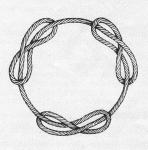 Chivalrous symbolism: in the Middle Ages, the Knots of Love is a sign of true and indissoluble friendship, of sworn and therefore unalterable faith. It was the insignia of the Order of the Holy Spirit, also known as the Node, founded in 1352 by Joan of Naples, for the coronation of her second husband, Louis of Taranto.
Chivalrous symbolism: in the Middle Ages, the Knots of Love is a sign of true and indissoluble friendship, of sworn and therefore unalterable faith. It was the insignia of the Order of the Holy Spirit, also known as the Node, founded in 1352 by Joan of Naples, for the coronation of her second husband, Louis of Taranto.
Philosophical Symbolic: Interlacings are a motive, omnipresent in Celtic art, which underlines the endless movement of evolution, of involution through the entanglement of cosmic and human facts. He then takes up the principle of ouroboros, a snake that bites its tail and symbolizes a cycle of evolution closed on itself. This symbol contains at the same time the ideas of movement, continuity, self-fertilization, eternal return. It is the union of the terrestrial and celestial worlds, signifies the union of two opposing principles (dichotomy): heaven / earth, good / evil, night / day. He is the infinite, the perpetual evolution.
Religious symbolism, Christianity: its infinite movement symbolizes the eternity, the immortality of the knight’s soul, the durability of the spirit of the Order. The necklace by itself, at least according to its simplest formula, offered three Lakes of Love; three as the divine number, three as the Trinity of God, at the same time Father, Son and Holy Spirit, three distinct “beings” but yet One (this is the Christian mystery of the “Three in One”), again reminiscent of the perfect equality of all, between them, and before God.
Read also The Poem as Green Girdle: Commercium in Sir Gawain and the Green Knight by R. Allen Shoaf

